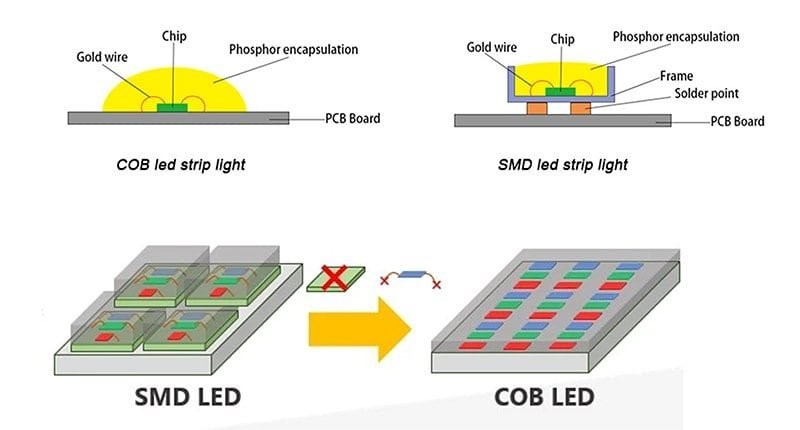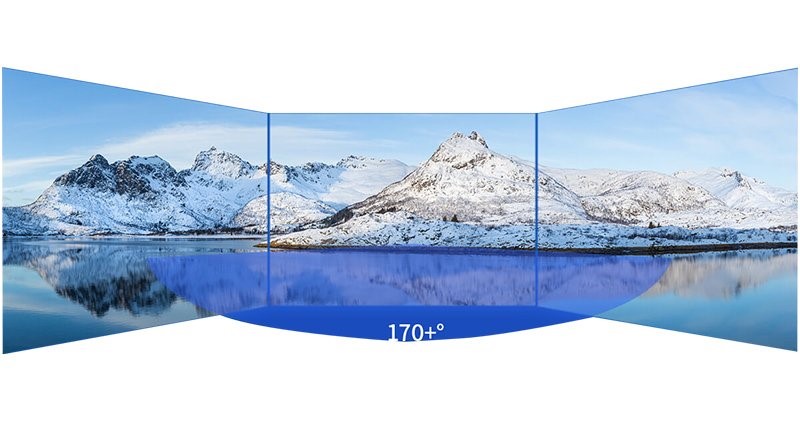What Is COB LED Screen?
COB (Chip on Board) is a kind of LED display packaging technology. Unlike traditional LED screens, COB technology involves mounting multiple LED chips directly onto a circuit board, eliminating the need for individual packaging. This consolidation enhances brightness, reduces heat emission, and enables a more seamless display. .
Advantages Over Traditional LED Screens:
COB LED screens outshine their counterparts in terms of performance. The absence of gaps between LED chips ensures uniform lighting, preventing issues like the “screen door effect.” Additionally, COB screens offer better color accuracy and higher contrast ratios.

Merits Of The COB LED Screen:
1. Retail and Advertising:
Owing to the diminutive size of the LED chip, COB offers a significantly heightened packing density when juxtaposed with Surface Mount Device (SMD) technology. This manifests as a more compressed array, ensuring enhanced uniformity, heightened intensity even in proximity, and superior heat dissipation, bolstering stability, reliability, and longevity. The encapsulation of COB chip and pin legs augments airtightness, fortifying resistance against external forces, yielding a seamless, polished surface. Moreover, COB boasts heightened resistance to moisture, ElectroStatic Discharge (ESD), damages, and dust, flaunting an IP65 surface protection rating.
Stable technology process:
As shown above, SMDs need to use reflow soldering. When the soldering paste reaches a temperature of 240°c the epoxy resin weight loss rate is 80% which easily causes the glue to separate from the LED cup, but in the case of COB technology there is no reflow soldering process so it is more stable..
A Closer Look: Pixel Pitch Precision
In the realm of education and corporate settings, flexible LED screens redefine the dynamics of communication and collaboration. From interactive presentations to virtual simulations, these displays facilitate engaging learning experiences and foster creativity. In boardrooms and classrooms across Saudi Arabia, flexible LED screens empower professionals and students alike to unleash their full potential.
The Saudi Arabian Perspective:
Pixel pitch, denoting the proximity of pixels on a display, undergoes refinement with COB LED technology. The smaller pixel pitch translates to increased pixel density, yielding superior resolution. This reduction in pitch ensures clarity even for viewers in close proximity to the display..
Illuminating the Dark: Light Efficiency:
Efficient heat dissipation and low light attenuation hallmark COB LED technology. Direct dispensing of the COB chip onto the PCB expands the heat dissipation area, surpassing the SMD counterpart in attenuation. SMD’s heat dissipation emanates from the bottom of its anchoring..
Expanding Horizons: Viewing Angles:
The small pitch technology within COB bestows a broader viewing angle, transcending indoor and outdoor scenarios with heightened brightness..

Indomitable Resilience:
COB stands resilient against collisions, impervious to the impact of Oil, Damp, Water, Dust, Oxidation, and dust.
High Contrast Ratio:
The contrast ratio, a pivotal metric for LED displays, achieves new heights with COB, boasting a static contrast ratio between 15,000 to 20,000 and a dynamic contrast ratio reaching 100,000.
The Green Epoch: Energy Efficiency
In the realm of energy efficiency, COB surges ahead of SMD, a critical factor in the operational cost of expansive displays subjected to prolonged usage.
The Shadows Of COB LED Display: Unveiling Drawbacks
Crafting Challenges:
The encapsulation of an LED display within COB mandates a defect-free lamp before refilling. Unlike SMD packaging, individual bulb replacement is unfeasible, intensifying the stringency of the packaging process.
Maintenance Dilemma:
Traditional SMD packaging allows for unit board disassembly after a single LED soldering repair. In contrast, COB products complicate maintenance, impacting surrounding lamps. Despite enhanced protection, a discernible dead light rate persists, necessitating unit board replacements. Although COB panels incur higher costs, their failure probability is substantially lower, making the maintenance cost comparable to SMD. As COB manufacturing costs decline, the trajectory suggests COB LED screens may soon eclipse SMDs in cost-effectiveness.
Choosing Xtreme’s COB LED Screen: A Wise Endeavor
Xtreme stands as display provider, presenting the COB LED Screen adorned with three distinct advantages:
Maintenance Dilemma:
Leveraging COB full flip-chip packaging technology enhances the performance and yield of small-pitch LED displays.
Exemplary Performance:
Xtreme’s COB LED displays embody attributes such as absence of light stringing, sharp imagery, vibrant color reproduction, efficient heat dissipation, prolonged lifespan, high contrast ratio, expansive color gamut, elevated brightness, and swift refresh rates.
Economical Elegance:
The COB LED Screen from Xtreme touts energy efficiency, facile installation, minimal maintenance requirements, low associated costs, and a commendable cost-benefit ratio.
Pixel Prowess:
Covering a pixel pitch spectrum from P0.5 to P1.86mm, Xtreme accommodates diverse user requirements.

- 1,200nits brightness
- 22Bit grayscale
- 100,000 contrast ratio
- 3,840Hz refresh rate
- Exceptional protection performance
- Single Module Calibration Technology
- Adherence to industry standards and specifications
- Proprietary optical display technology prioritizes eye protection
- Versatile applicability across various scenarios













